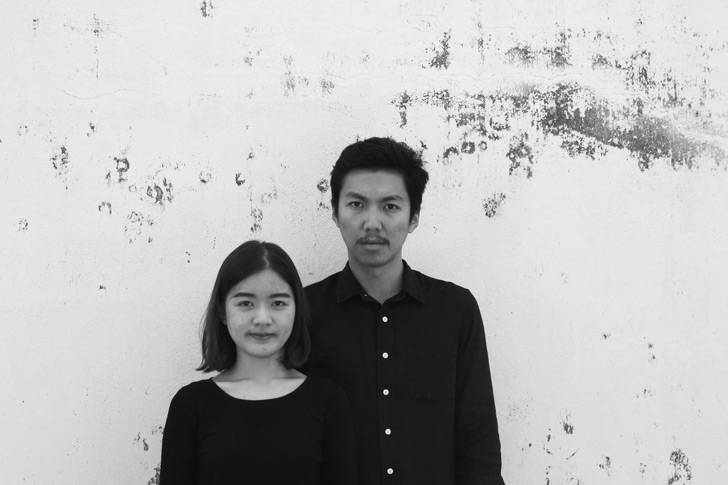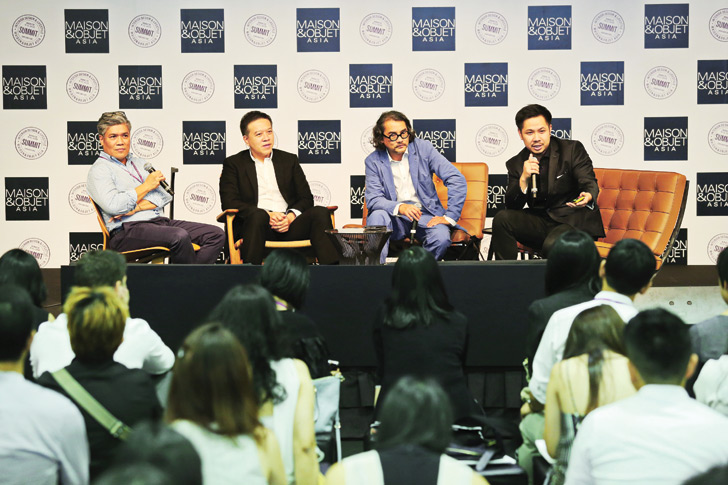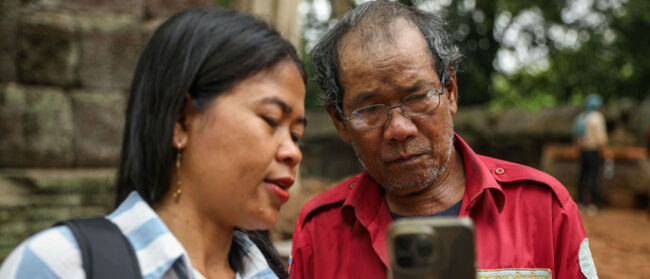Anon Pairot flips through his PowerPoint presentation; the slides are quirky, not what a visitor to the design summit at Maison & Objet Asia may have anticipated. It is the region’s most prestigious interior design event, and top designers from as far afield as Italy and Japan are in attendance. Up on the screen, internet memes and images of monkeys appear at what seem like random intervals.
It is unexpected, and that’s exactly the point designer and artist Pairot is trying to make. He’s been asked to speak on the theme “Bangkok Meets World: Thai Designers Gear Up for High Market Expectations”, but instead he’s confounding audience expectations.
“It’s a very common word but I think we don’t always understand it,” he explains to the gathered crowd. “Expectations for yourself are very different to the expectations of your client.”
Pairot, who has his own design studio, is part of an emerging movement in Thai interior and architectural design that Manrat Suensilpong, a veteran of the industry, has termed the “new species” of Thai designer. They are at the forefront of the country’s design industry – the kind of designers who revel in turning expectations on their head.
“What are they doing differently to set them apart from others? Basically it’s a hybrid of three things, from my experience: first, they are a group of great Thai designers, like Anon, who design products that are really appealing to the international market. But they not only design products, they also develop the products, do the research by utilising their very talented people and then manufacture the product to the end user,” says Suensilpong, who is well-attuned to the pulse of the industry. He is the business development director at furniture design firm Kenkoon, where he has worked for 11 years, as well as the vice-president of the Design & Objects Association and he sits on the board of the Thai Furniture Industries Association.
Thai design has come a long way in the past three decades. As Suensilpong explains, Thailand was among the first countries to benefit from the production migration of European and US manufacturers looking to take advantage of cheaper labour costs overseas. “This was really the good time for the Thai furniture industry,” he says. But of course, nothing lasts forever.

“The coming of China, they reformed their economy and opened up the country… Thailand was not cheap any more [by comparison]. These [manufacturers], they gradually moved out to other countries with cheaper labour.”
Thai design
The question on everyone’s lips was the same: how to return to the glory days? Companies such as Kenkoon, and others – Suensilpong namechecks Mobella, Dots Design Studio, PDM Brand and Niiq – began establishing themselves in order to combine high-end design with product development and production services. While Kenkoon has been around for the better part of a decade, Suensilpong says the past four to five years has seen a surge in new firms coming on board.
“They are the guys who previously designed for the international brands or for other companies, but now they stand up and they’re making everything themselves. And, finally, customers just love it,” he says. “For the cheap products, we have so many countries who do that. But for customised, beautiful products we are the kind of species that specialise to do something like this. In Thailand, we have many people like this now.”
This ability to create unique, appealing products is, in large part, what has driven the success of this new wave of designers in Thailand. Duangrit Bunnag, the founder of his eponymous architectural firm and winner of an abundance of awards for his luxurious projects, says Thai design has evolved “tremendously” in the past decade.
“I think the younger generation have had more freedom in recent years to express themselves, and I think that’s very important,” he says. “With or without the support of the government, they managed to actually have a breakthrough in the barrier that we had in the early generation of mine… It was something deep in culture, it’s a notion of Thai culture that the young people have to keep themselves modest and not speak out.
“If you speak out, they will consider you rebellious and not a good boy or good girl. But I think that the later generation, they have managed to achieve that breakthrough; to be able to speak out and say some things using politically incorrect words.
“But, anyway, they are making a difference. Freedom is something I don’t see in the political domain, but in the cultural domain, it has allowed the Thai designers to get better.”
Although the more established design figures agree that this design evolution has been happening organically, they are also trying to nurture others’ talents: Bunnag is a member of the Bangrak-Klongsan Creative District steering committee, a project to “create a conversation about creativity” in urban areas by encouraging innovative and artistic projects to emerge in two Bangkok districts; Pairot organises design conferences in Thailand and is enthusiastic about, rather than wary of, up-and-coming talents who others might see as competition.
“A long time ago, we didn’t have a platform for designers… And [because] we have more designers [now] we need more platforms to let everyone share ideas and update new designs,” Pairot says. “So we started to make a platform to invite not just Thai people, but people from Korea, China, Singapore who can come to talk, to show their ideas. It’s not [just] about furniture or product or anything – if they have good ideas we want to invite them to come to Bangkok to show these, to network.”
This “people-to-people” ap-proach is not driven entirely by altruistic motives, however. Pairot says it comes down to business – buyers are more likely to be attracted to a market bursting with clever design ideas.
“Why shouldn’t they come together as friends not competitors? [Previously], they thought that if you produce something you need to find some competitors, but no. For me, everyone can be friends. Because when the good products stay together, it’s a good market.”
Nichepak Torsutkanok, the co-founder, along with her partner Wanus Choketaweesak, of embroidery-cum-design studio Ease, could easily be counted among this new wave of emerging Thai designers. Launched in 2014, Ease was chosen as one of six ‘Rising Asian Talents’ at Maison & Objet in recognition of their large-scale works with an industrial bent. Look a little closer and the fine threads that make up each hand-embroidered piece become visible.

“I like it because you don’t know what it is [at first glance], but they start from technique… They start from detail, not from the whole picture. That is a good thing, because they’re going back to find good details and questioning whether that detail is good enough to be something [whole]… so they think in reverse from the [usual] process,” says Pairot of the couple behind Ease, who have caught the attention of clients – mostly hotel and restaurant projects – from all over Thailand and beyond.
Torsutkanok says that she and her brand have benefited from being part of the circle of young Bangkok designers who focus on bespoke products because it offers a supportive environment: “We have the same kind of attitude to create the same kind of product – not mass-production, we need craftsmanship.”
However, the duo behind Ease is also aware of the importance of those who have blazed a trail before them. “I think the younger generation can see from the senior [designers], what they have done; they can learn from them,” says Torsutkanok.
According to Bunnag, the key takeaway for Thai designers is that clients are no longer interested in where a designer comes from or what their background is; they simply want the best of the best, and Thai firms must continue to keep pace with developments.
“It’s not about culture, it’s not about notion of nation any more, not even sometimes about places,” he says. “They don’t hire Thai architects just for the sake of the culture, they hire you because you’re good. And that’s the whole idea.”


